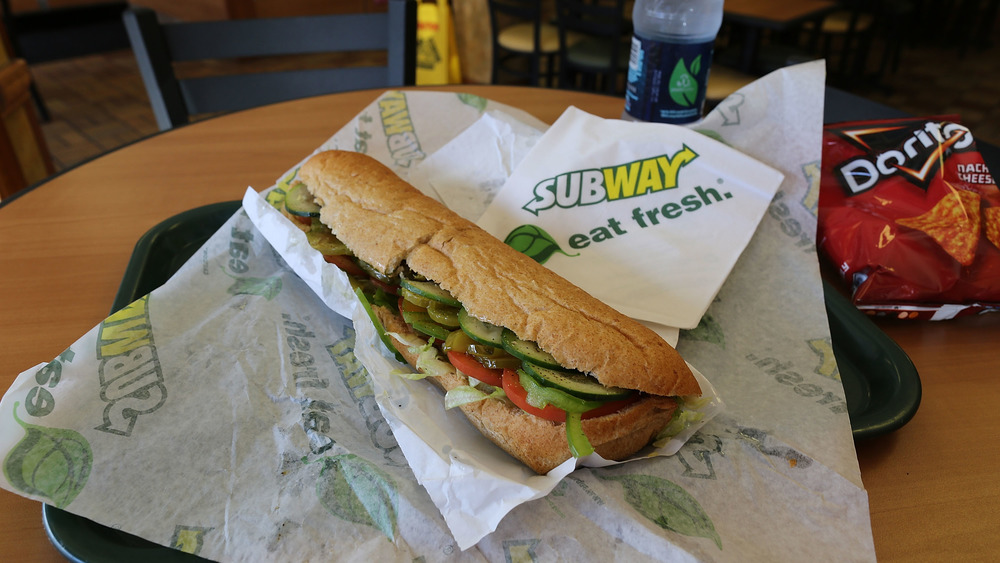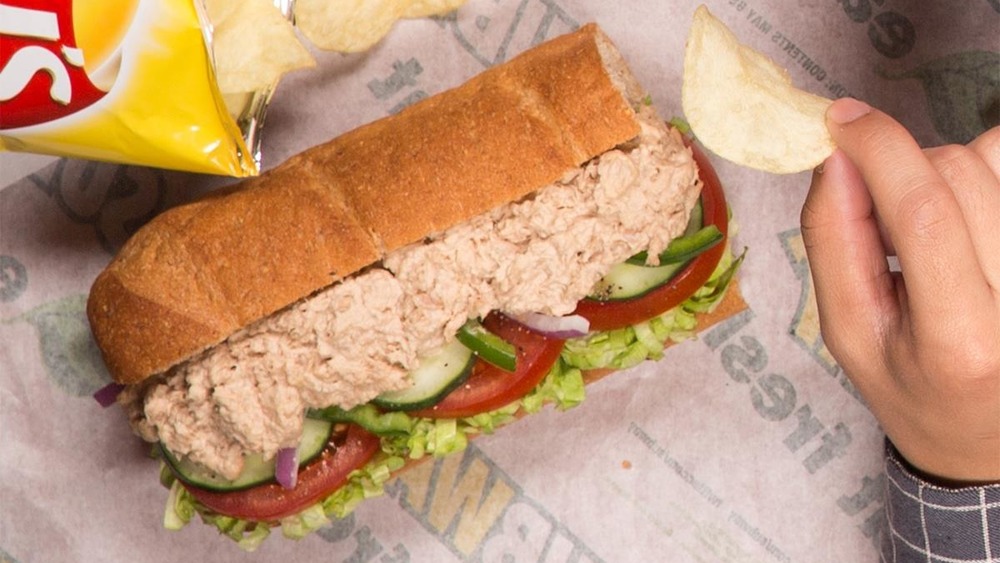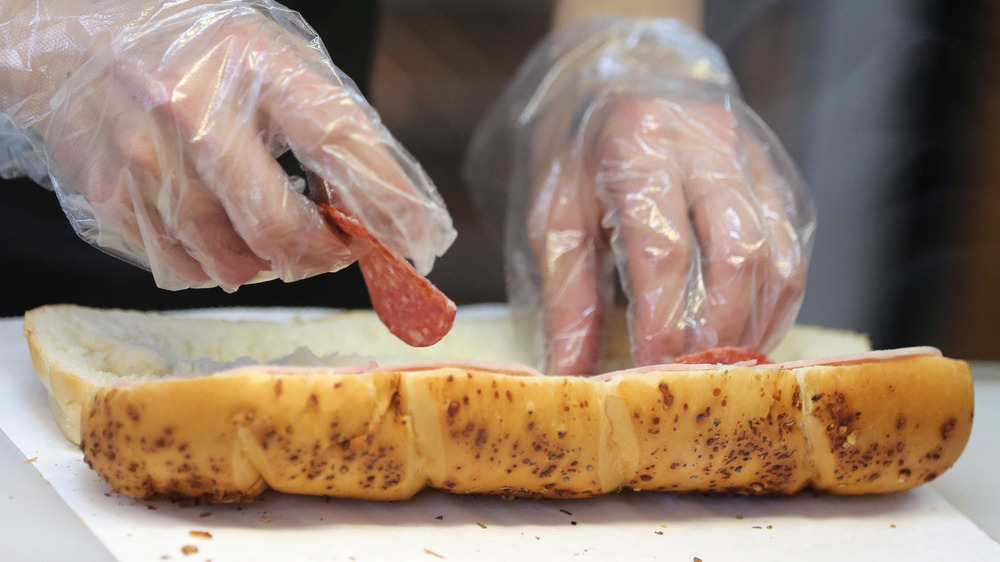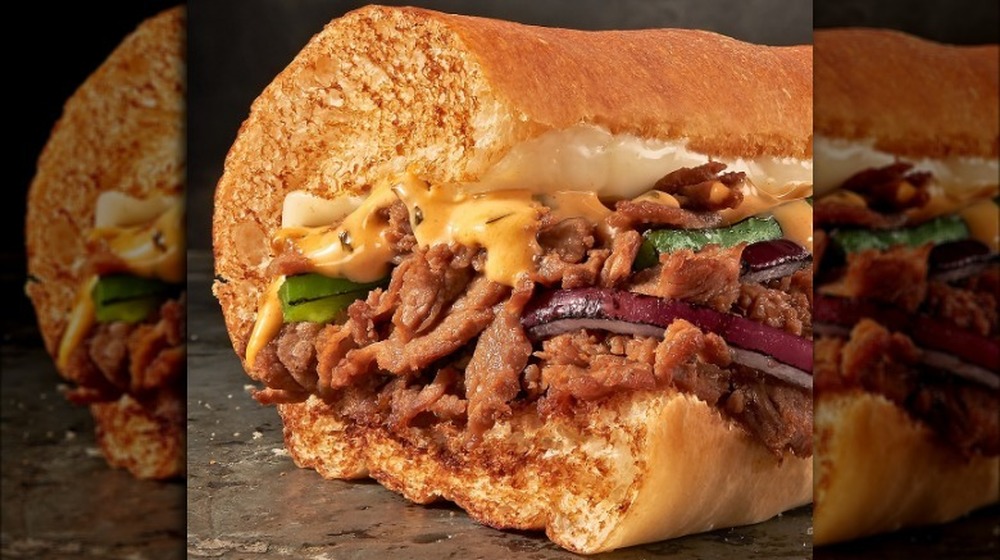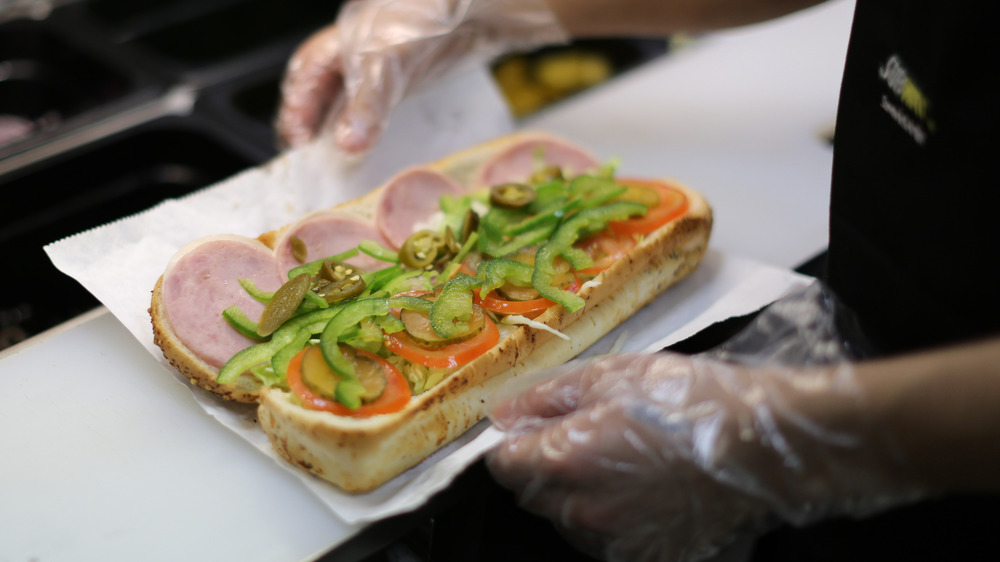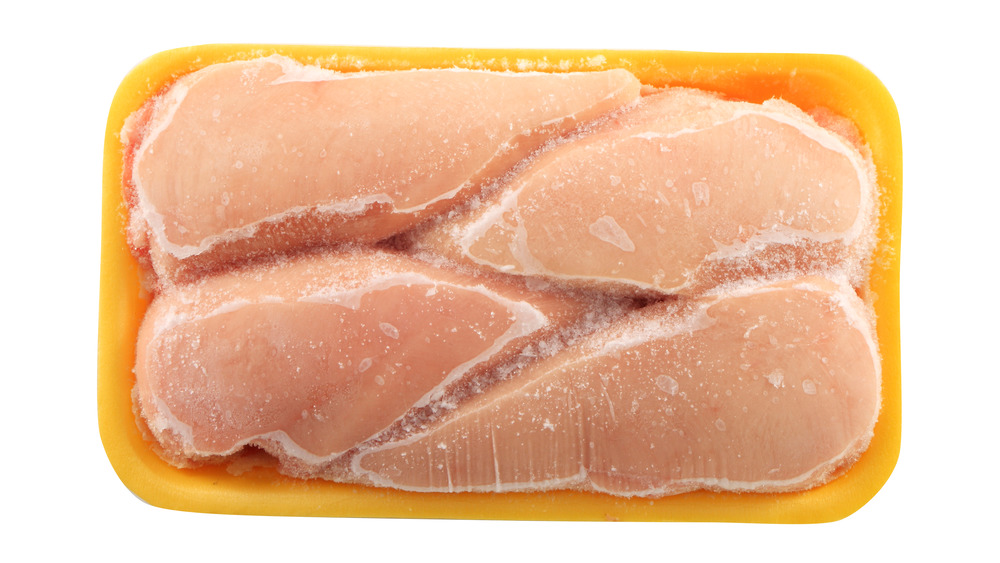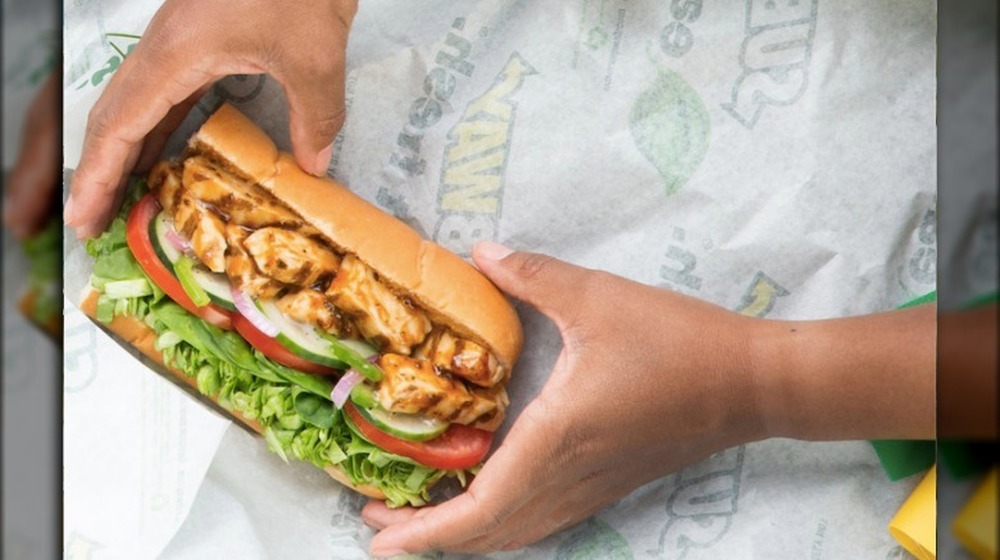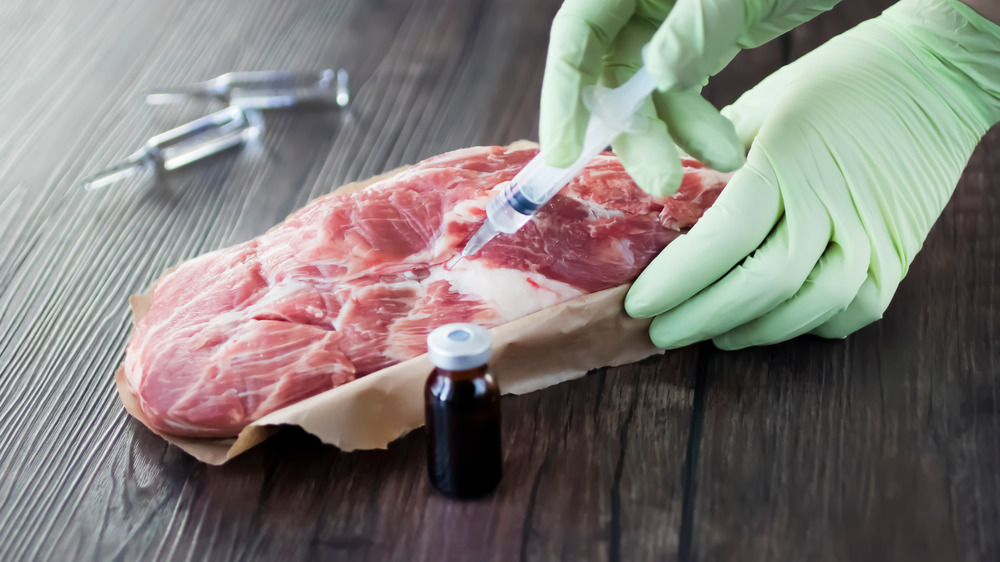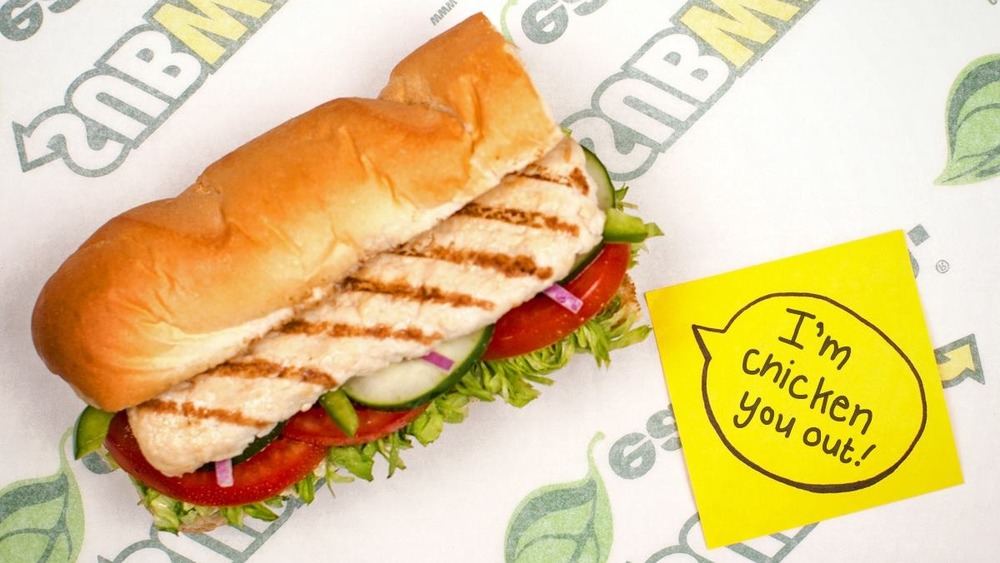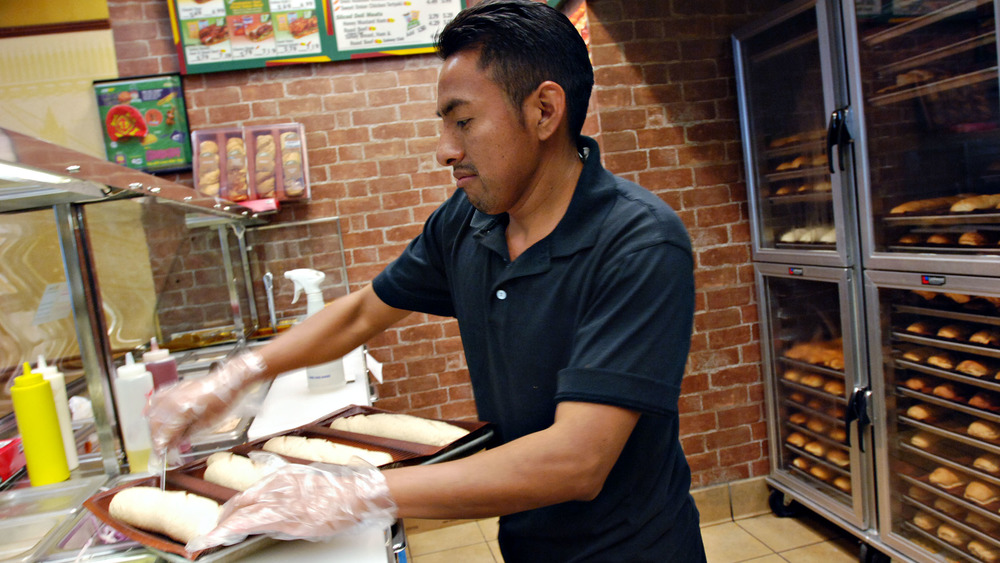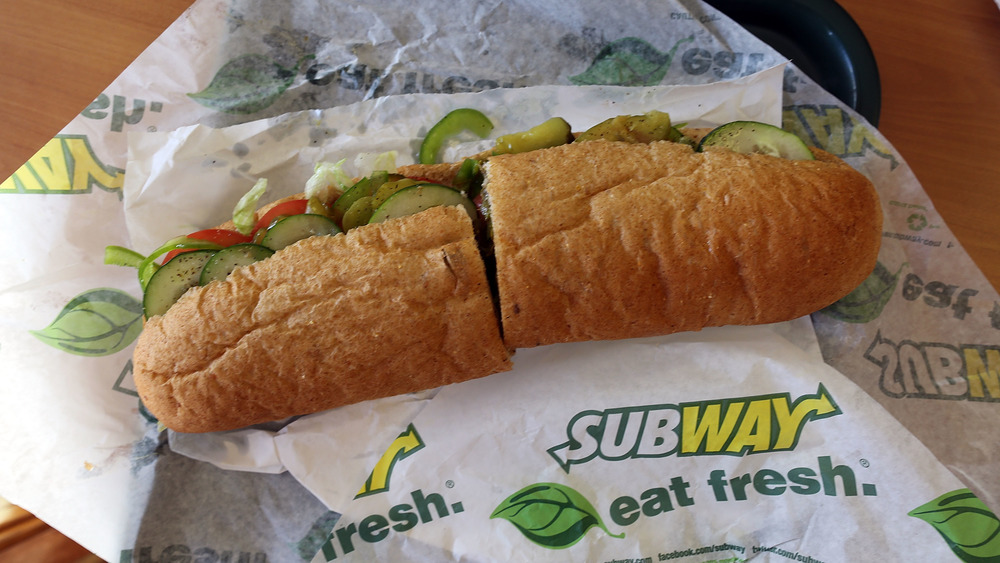The Food At Subway Isn't Really What You Think It Is
Despite some recent struggles, Subway remains a giant in the fast food world. With nearly 24,000 locations, it is the largest restaurant chain in the country, and it brings in billions of dollars in revenue each year. But with great power comes great responsibility, and Subway has not always lived up to its end of the bargain. In particular, the chain hasn't always delivered to its customers the food they think they are getting.
Nearly every aspect of a Subway sandwich — the meat, the vegetables, and even the bread — has come under scrutiny for not being what the restaurant claims it to be. In some instances, the company has acknowledged its faults and corrected the problem. Other times, Subway has been defiant and pushed back against accusations. So whether it's getting cheated out of an extra inch of sandwich, eating bread filled with unpronounceable ingredients, or devouring tuna that might not actually be tuna, here are a few examples of food at Subway that isn't really what you think it is.
Subway's tuna may not actually be tuna
Subway is no stranger to the accusation that it serves mystery meat. Not too long ago, a Canadian news outlet conducted DNA analysis on the sandwich maker's chicken to find that the meat was, in fact, only 50 percent chicken. Subway's latest protein controversy centers on the chicken of the sea. A lawsuit filed in U.S. District Court for the Northern District of California alleges that Subway's tuna is not tuna at all. The lawsuit states that the ingredient is "a mixture of various concoctions that do not constitute tuna, yet have been blended together by defendants to imitate the appearance of tuna."
It wouldn't be the first time a restaurant passed off one fish for another. But the most troubling part of this new allegation is the claim that what Subway is calling "tuna" isn't a cheaper fish substitute. Speaking with The Washington Post, an attorney for the plaintiffs claimed lab tests showed the ingredients were "not fish," declining to say what precisely what they found to be were. This makes one former employee's claim that the tuna salad was one bag of tuna and three bags of mayonnaise look like an upgrade.
Subway denied the allegations, but the plaintiffs argued they "were tricked into buying food items that wholly lacked the ingredients they reasonably thought they were purchasing" before the lawsuit was eventually dismissed in 2023.
Overseas, a court ruled Subway's bread didn't qualify as actual bread
Subway received a particularly humbling piece of news in late 2020 when Ireland's Supreme Court ruled that the restaurant's bread was, believe it or not, not actually bread – at least in the eyes of the law.
The problem, according to the court, is the amount of sugar Subway includes in its bread recipe. Ireland's Value-Added Tax Act allows "staple" foods, including bread, to be exempt from certain taxes. But the law only allows bread's sugar to be a maximum of 2 percent of the weight of flour, otherwise it's more of a pastry. Not only does Subway's bread recipe have more than the allotted sugar amount, it has five times more.
The case was brought to the court by an Irish franchisee who was hoping to get a tax refund. It clearly did not work out in their favor. The franchisor was none too pleased either, pushing back against the ruling — without arguing the court's reasoning. They issued a statement, saying "Subway's bread is, of course, bread. We have been baking fresh bread in our restaurants for more than three decades and our guests return each day for sandwiches made on bread that smells as good as it tastes."
Subway's food is not as healthy as it seems
Subway was able to establish itself as one of the quick-service restaurant giants by promoting itself as the healthier alternative to traditional fast food. But the healthy reputation isn't entirely accurate.
In general, Subway does offer a wider array of healthier options than the average burger joint. But you need to be careful what you order, and what you're adding on to that order. Although many sandwiches are low in things like sugar, they often have bloated fat and sodium levels. And the restaurant does its best to hide this, as one former employee explained. "When you walk into a Subway store, you'll see all of our menus have the calories listed with each sandwich ... What you can't read is the small print on the menu, which specifies that these values are only for a six-inch sub, on 'standard recipe' (nobody knows what the [heck] that is) white bread, with no cheese or sauce."
Therefore, you can easily be tricked into thinking you're getting a low-fat, low-calorie sandwich. But if you're ordering a foot-long sandwich with cheese and sauce (which 99 percent of the customers do, according to the employee), you're roughly tripling those numbers.
Some Subway ingredients aren't even clean
Restaurant customers are entitled to the reasonable expectation that their food is clean and won't make them sick. After all, people won't go back to restaurants that give them food poisoning! But if we are to believe former Subway employees, the sandwich chain doesn't always pass that minimum standard.
According to multiple people on Reddit who have worked at Subway stores, it is common for the restaurant to not wash the vegetables it serves. One employee stated, "Our manager told me not to bother washing or rinsing boxed vegetables like green peppers and tomatoes," adding that, "at least a few of them are rotten every time."
Another former employee had even worse stories to tell. In addition to agreeing with the unwashed vegetable claim, they also said that the same slicer used to cut dirty vegetables was then used to cut deli meat without being washed first. One more food safety violation accusation involved olives and peppers, which the employee said come delivered to the stores in bags. "They taught us to hang the bag over the dishwashing sink while they drain. That means that while we wash the dishes using industrial strength sterilizer, your peppers and olives are getting splashed with it."
Subway's fresh food is often frozen
The word "fresh," as in Subway's famous tagline "Eat Fresh," may not have a clear definition when it comes to food. But there's a general assumption that fresh food has been procured recently and has remained in the same condition by the time it reaches your plate (in other words, it was never frozen). Apparently, Subway's advertising is more than a little misleading when it comes to the freshness of its food.
"I worked at Subway: NOTHING was fresh, everything was frozen, even the lettuce was precut in a bag in the freezer," said one former employee on Reddit. "The meat, same deal, the bread was in little frozen dough balls. I don't understand how they can say 'eat fresh.'"
Another former Subway employee seconded the frozen bread claim, saying, "[The manager] kept frozen (unbaked) bread for over a year. It was so old that the yeast had died, causing the bread to not rise."
It appears things aren't much better overseas. A Subway worker in the United Kingdom stated a number of items sold at the restaurant are frozen. "Steak, chicken, chicken strips, bread, etc., comes frozen and is thawed before prepping and serving ... The cookies are shipped to us in bags of frozen dough balls. They're cooked in store in our oven."
Some Subway food may be expired
Food expiration dates are undoubtedly confusing and many people throw away perfectly good food simply because they believe it has gone bad.
But by and large those dates exist for consumer safety, something restaurants should take extremely seriously. According to Food Service Director Magazine, the National Restaurant Association recommends its members follow to the FDA Food Code, which states, "The day or date marked by the food establishment may not exceed a manufacturer's use-by date if the manufacturer determined the use-by date based on food safety."
All this is to say that restaurants should be adhering to the expiration dates their ingredients are given. But some Subway franchisees are doing the opposite. One Reddit poster, a former Subway employee, claimed their manager "was really conscious of food costs ... to a fault. Most commonly was changing the expiration dates of food so it wouldn't have to be thrown out. This may not be a huge deal for a couple days, but food would last a couple WEEKS."
The sandwich artist wasn't alone in announcing their warning. Another employee advised customers to specifically avoid the chicken teriyaki. "Subway chicken is given a two-to-five day shelf life depending on the variety," they said. "The chicken teriyaki SHOULD be thrown out by the fifth day, but a lot of employees just change the date to avoid throwing it out. This means, with shift changes, varying staff and other factors, five-day chicken could be out as long as nine days."
Subway's fresh food was filled with additives and preservatives
It has historically been a common practice among fast food restaurants to use preservatives and additives in their food, and Subway is no different. But few such eateries advertised their food as "fresh," which makes Subway's actions a little more devious.
In addition to the yoga mat chemical, some Subway breads had tasty ingredients such as sodium stearoyl lactylate and ammonium sulfate, both used to help condition the dough. The restaurant's protein wasn't any better, containing artificial flavor enhancers such as autolyzed yeast extract, hyrolyzed corn gluten, and hydrolyzed soy protein. CBS News once described Subway's meat as, "a processed concoction of actual meat and lots of water that's held together by things like modified food starch and soy protein concentrate, and then goosed with artificial flavorings."
Those looking at Subway as a healthier quick-serve option will be happy to know the restaurant has said goodbye to these artificial ingredients. In an attempt to get closer to its "Eat Fresh" slogan, Subway announced in 2015 that it would be removing all artificial colors, flavors, and preservatives from its menu by 2017.
Subway's chicken was once found to only be half chicken
Most fast food restaurant goers likely know the food they're eating isn't the freshest and may have things like additives and preservatives. But most probably also assume that the food they're eating is, in fact, the food they ordered. In 2017, a Canadian news program claimed that if you're eating Subway's chicken, that assumption is wrong.
An investigative team from CBC's Marketplace studied DNA analysis of several fast food restaurants' chicken sandwiches. The chicken from most eateries, including McDonald's, Wendy's, and Tim Horton's, were found to have between 80 and 90 percent chicken DNA. Not so much for Subway. The sandwich outlet's chicken was found to be only half chicken — oven roasted chicken contained 53.6 percent chicken DNA while the chicken strips were 42.8 percent, to be exact. What did the rest of this hybrid meat consist of? Soy.
For its part, Subway strongly denied that accusation, going as far as sending the chicken to two different independent labs, which found the samples to have less than one percent soy. "The allegation that our chicken is only 50 percent chicken is 100 percent wrong," Subway president and CEO Suzanne Greco said in the statement at the time.
Subway's bread recipe once included yoga mat material
They may differ slightly depending on the type you're making, but the main ingredients of bread are pretty simple and familiar: flour, water, and yeast. So when you come across an unpronounceable ingredient name like azodicarbonamide, there is probably cause for concern. And yet not long ago, that chemical was found in Subway's bread.
In 2014, food blogger Vani Hari publicly chided Subway and demanded they remove the chemical, which can also be found in, of all things, yoga mats and shoe soles. In bread, it is used to strengthen dough. In Subway's defense, it's a common commercial bread ingredient that was also used at other restaurants including McDonald's, Starbucks, and Arby's. In addition, according to Subway and the American Bakers Association, the FDA had found azodicarbonamide to be safe.
That didn't stop Hari from starting a petition to get the chain to remove the ingredient from its bread, which quickly gained more than 65,000 signatures. Hari pointed out that Subway did not use the chemical in its European and Australian stores (likely because the substance is banned there).
In the same week the petition launched, Subway announced it would be removing the ingredient from its bread, a process it said had begun prior to public lambasting. "Even though this ingredient is safe, we are removing it from Subway bread," the company said at the time. "This process began last year ... We should complete the entire conversion process within the coming weeks."
Subway's footlong sandwiches haven't always been a foot long
Not only is the quality of food at Subway not what you think, the quantity has come up short as well. In 2013, two men from New Jersey sued the restaurant, claiming that Subway's signature item, the Footlong sandwich, was just 11 inches long.
It all started when a man in Australia illustrated the difference by posting a photo on Facebook showing a Footlong sandwich next to a ruler. Then the New Jersey duo demanded Subway make sandwiches twelve inches long or stop advertising that they are. Subway claimed that "Footlong" was just an adjective and not used to state the exact size of the sandwich (an argument Stephen Colbert was happy to shoot down).
It took two years but Subway finally relented. As part of the lawsuit settlement, the chain was required to ensure all sandwiches are, in fact, the size advertised (their smaller size sandwiches were also found to be shorter than advertised). It also agreed to change its training and franchisee material, which "previously allowed for a small tolerance in the size of the Footlong sandwich."
